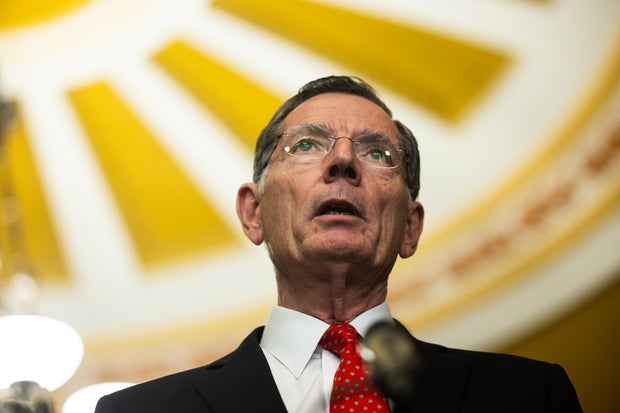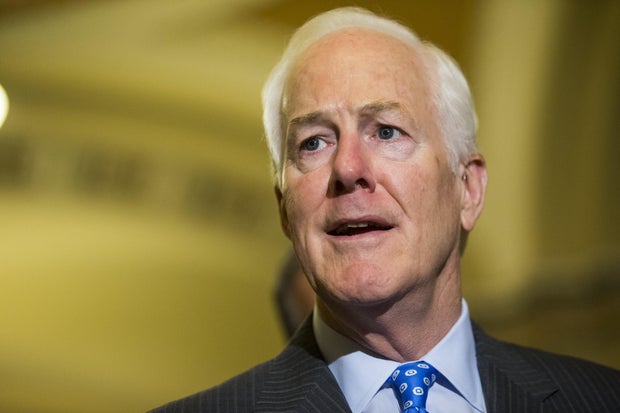CBS News
Who might replace Mitch McConnell? An early look at the race for the next Senate GOP leader
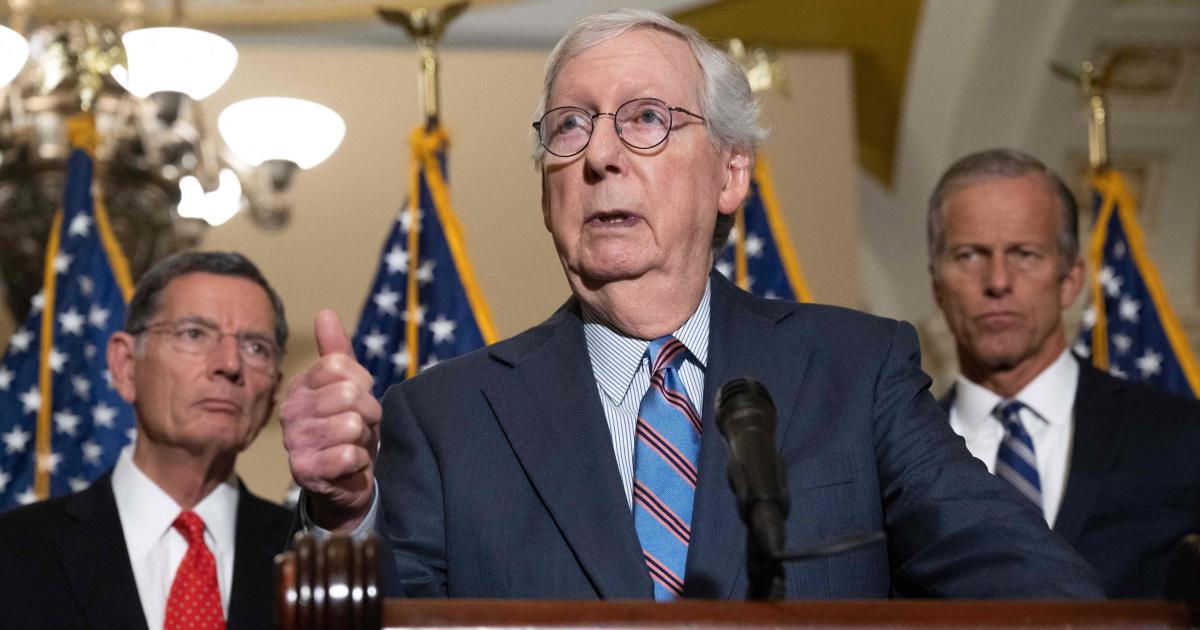
Washington — Senate Minority Leader Mitch McConnell announced on Wednesday that he will step down from leadership after November’s elections, teeing up a race for the top Republican post in the Senate that has been years in the making.
McConnell’s retirement from leadership marks the end of the longest-serving leadership term in Senate history, after 17 years at the party’s helm. And with months until the conference gathers after November’s elections to select a new leader, the announcement kickstarts a lengthy campaign for the job.
“Whoever replaces him is going to have big shoes to fill,” Sen. Susan Collins, a Maine Republican, told reporters on Wednesday.
No senator has announced an intention to run, and the race will surely fluctuate in the weeks and months to come. But a handful of GOP senators are seen as possible replacements: John Barrasso of Wyoming, John Cornyn of Texas and John Thune of South Dakota. All three have all served in GOP leadership, and have close to or more than 20 years of experience in the upper chamber. Sen. Rick Scott, a Florida Republican who unsuccessfully challenged McConnell for the leadership post in 2022, could also throw his hat into the ring.
John Barrasso
Tierney L. Cross/Bloomberg via Getty Images
Barrasso, 71, is the GOP conference chair. The No. 3 Senate Republican first came to the Senate in 2007. The orthopedic surgeon previously served in the Wyoming state senate and serves atop the Senate Committee on Energy and Natural Resources. Barrasso is widely seen as the most conservative of the three men.
John Cornyn
Samuel Corum/Anadolu Agency/Getty Images
Cornyn, 72, previously served as the Republican whip from 2013 to 2019. He was first elected to the Senate in 2002, after working as a member of the Texas Supreme Court, and serving as Texas attorney general. The Texas Republican has a long history as a prolific fundraiser, which could be a boon should he run for the top Senate post.
John Thune
Valerie Plesch/Bloomberg via Getty Images
Thune, 63, has served as the Republican whip since 2021. The No. 2 Senate Republican, who some view as the favorite for leader, was first elected to the chamber in 2004, after three terms in the House of Representatives. Days ago, he became the latest member of GOP leadership to endorse former President Donald Trump’s White House bid. McConnell remains the sole holdout among top leadership.
The South Dakota Republican, considered the most moderate, noted to reporters on Wednesday that McConnell’s move leaves “big shoes to fill,” but he made clear that “there’s plenty of time” for the jockeying for leadership going forward.
“Today we just want to reflect on his service and honor him for that, and then we’ll go from there,” Thune said.
Rick Scott
(Tom Williams/CQ-Roll Call, Inc via Getty Images)
Scott, 71, was elected to the Senate in 2018. The former Florida governor launched a leadership challenge against McConnell after the midterm elections in 2022, helming conservatives opposition to the long-serving leader. At the time, Scott earned the support of just 10 members of his conference, suggesting his bid for the post could be a long-shot.
But he seemed to suggest interest on Wednesday, reminding onlookers of his bid for the leadership in a statement and saying he has “long believed that we need new leadership in the Senate.”
The likely GOP presidential nominee could have a significant impact on the race. When asked whether Trump will have a say in who replaces McConnell, Sen. Joni Ernst, an Iowa Republican and the No. 4 Senate Republican, said “he may.”
“But again, we’ve just got a lot of talent. We really do,” she said. “We’re blessed with that.”
Alan He and Alejandro Alvarez contributed reporting.
CBS News
How Donald Trump and Kamala Harris could reach 270 electoral votes

Watch CBS News
Be the first to know
Get browser notifications for breaking news, live events, and exclusive reporting.
CBS News
Republican Rep. Elise Stefanik on Election Day issues, Trump’s potential return to office
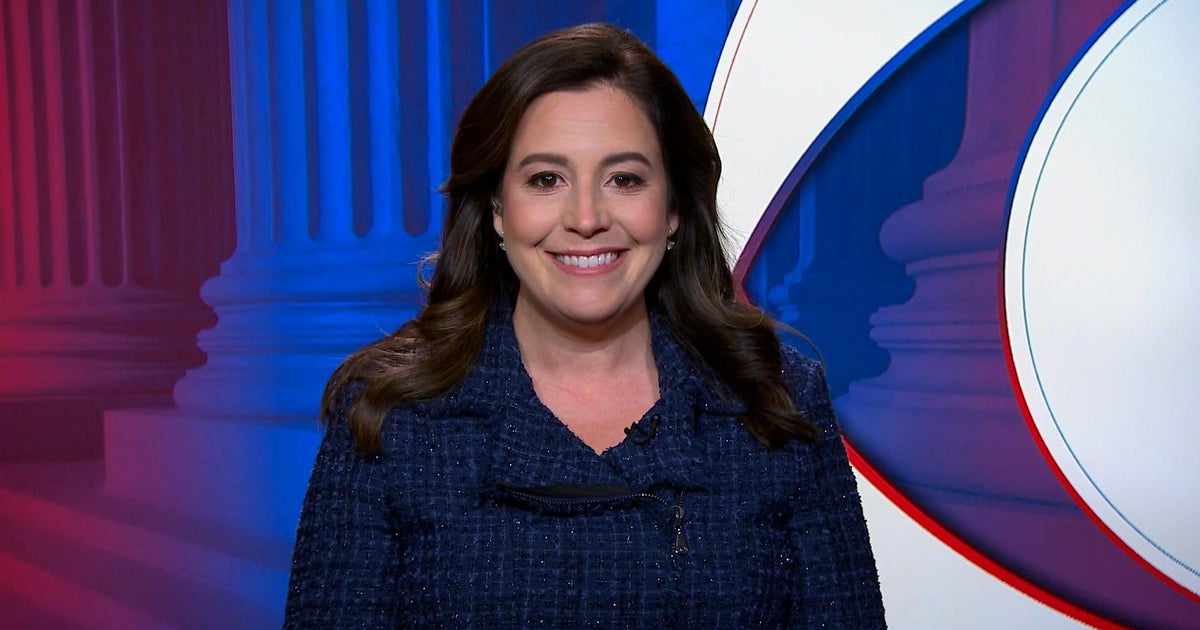
Watch CBS News
Be the first to know
Get browser notifications for breaking news, live events, and exclusive reporting.
CBS News
When will we know the presidential election results? A state-by-state guide
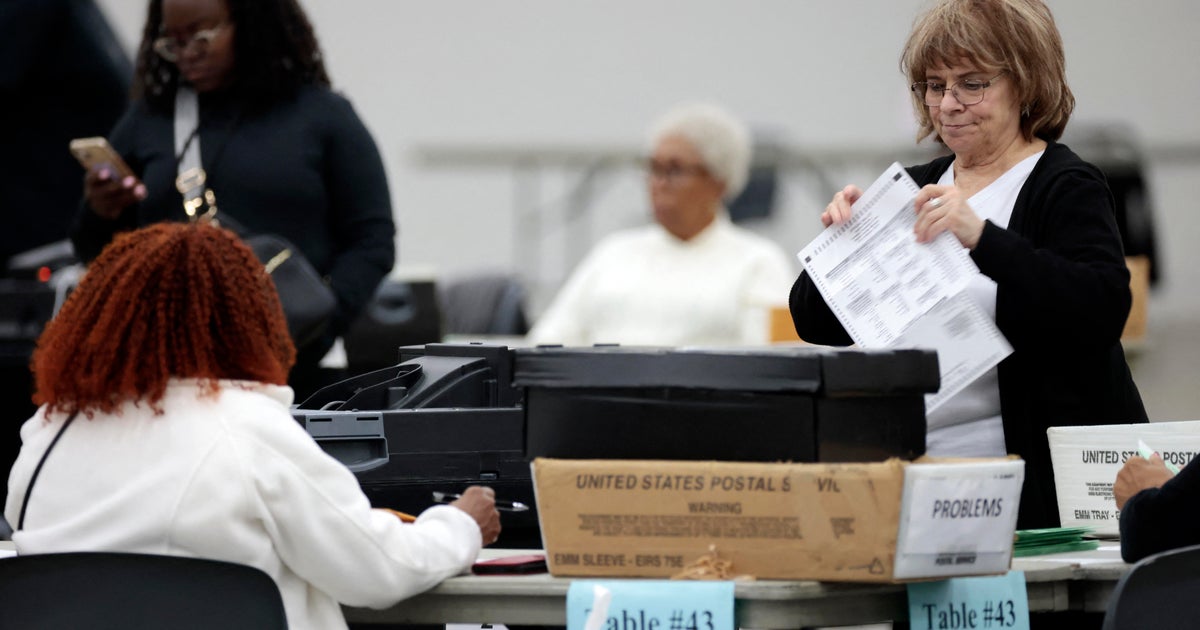
Waves of election results will begin coming in Tuesday night after polls close throughout the country, but in many key states it may take a while to know who has won — and much longer to get official, certified results.
There are a number of reasons it can take longer for ballots to be counted in some states, including the rise of mail-in voting, an option taken by nearly one-third of voters nationwide during the 2022 midterm elections, according to the MIT Election Lab. Some states allow mail-in ballots to be counted before Election Day, while others do not allow poll workers to start counting those ballots until in-person voting has come to an end.
CBS News considers seven states to be battleground states in the 2024 presidential election. Here’s a breakdown of those states’ rules around official ballot counts and certification.
Arizona
Polls close in Arizona at 7 p.m. local time (9 p.m. ET).
Arizona has allowed voting by mail for over two decades, and approximately 80% of voters in the state vote by mail. Ballot processing and tallying in the state can begin when the ballots are received by election workers, but results may not be released before all precincts have reported or one hour after the polls close on Election Day, whichever is sooner. Releasing information earlier is a felony in Arizona.
University of Arizona professor Christopher Weber, who leads the Arizona Voter Project, said it could be nearly two weeks before every vote is tallied in the state’s most populous county.
“The polls are really close in Arizona, and Maricopa [County] is expecting 10 to 13 days to count all votes,” Weber said. “I – like others – anticipate delays. Though we may have predictions beforehand, it’s really difficult to say. I don’t remember a time in which polling was so close.”
County elections officials are responsible for the counting of ballots in federal, state and county elections, according to the state elections website. Early and provisional ballots first undergo signature verification at a county recorder’s office, and counties can begin tabulating votes once early voting has begun. Most early ballots will be counted before Election Day, while those that are received on Election Day will be tabulated in the days immediately afterward.
An automatic recount is triggered if the margin of the votes between two candidates is 0.5 percentage points or fewer. Recounts may not be requested in Arizona.
Since 2020, the state has been the epicenter of a campaign among Trump supporters to undermine trust in the nation’s election systems, leading elections officials in the state’s largest county to erect a veritable fortress to defend the center where votes are counted.
Georgia
Polls close in Georgia at 7 p.m. ET.
Absentee ballot voting in Georgia plummeted after the 2020 election, when more than 1.3 million residents availed themselves of that option. During the 2022 midterm elections, that figure was below 300,000, a figure advocates blamed on a controversial 2021 law that reduced access to ballot drop boxes, increased restrictions on mailed ballots and introduced other rules like banning food and drink distribution to voters in line by non-poll workers.
That legislation was among a string of changes implemented in the last four years by the state’s Republican-dominated government. In September, Georgia’s State Election Board approved a requirement that ballots be counted by hand after machines tally the votes. But that and other recently adopted rules were blocked by Georgia judges who concluded they were adopted too close to Election Day.
Emory University professor Andra Gillespie said if the race is close, once again it may take time for it to become clear who’s won.
“In general, I want to prepare people for the possibility that it may take a couple of days to count, and just because it may take a couple of days, that doesn’t mean people are manipulating the system,” Gillespie said.
Georgia law requires that the vote be certified “not later than 5:00 P.M. on the Monday following” the election, but since this year that Monday falls on Nov. 11, Veteran’s Day, that deadline has been moved to the following day, Tuesday, Nov. 12.
The deadline for either candidate to request a recount is two days later, Thursday, Nov. 14. In Georgia, a losing candidate may petition for a recount when results are within 0.5% of total votes cast for the office.
Michigan
The last polls close in Michigan at 9 p.m. ET. (While polling places in much of the state are in the eastern time zone and close at 8 p.m., some western counties are on central time.)
About 42% of Michigan voters in 2022, 1.9 million, cast absentee ballots, down from 59% in the 2020 presidential election, according to local news site MLive.com.
Oakland University professor David Dulio said it can be hard to predict when the state’s winner will be apparent, because “elections in Michigan are very decentralized.”
“Our elections are run by 1,600 different local clerks who all have to do all of that work and then send it up the chain. That has the potential to slow things down,” Dulio said. He added that the state’s largest city, Detroit, “is notoriously slow,” and its third largest city, Warren, will not be taking advantage of a relatively new state law allowing clerks to pre-process absentee ballots up to eight days before Election Day.
County boards of canvassers have up to 14 days after the election to complete their official counts, which are then turned over to a state board. The Secretary of the Board of State Canvassers must announce a winner by Nov. 25.
In the event of a close race — with the two candidates separated by fewer than 25,000 votes — Michigan law encourages the state board to expedite its canvass “as soon as practicable.”
If the candidates are within 2,000 votes, an automatic recount is triggered, but it must be completed within 30 days of the election.
Nevada
Polls close in Nevada at 7 p.m. PT (10 p.m. ET).
Beginning in 2022, Nevada became one of eight states to conduct all-mail elections, in which every citizen is delivered a vote-by-mail ballot with a pre-paid postage, though in-person voting at polling locations is also allowed.
The state’s board of county commissioners is required to complete county-level canvasses by Nov. 15, which is 10 days after the election.
Sondra Cosgrove, a professor at the College of Southern Nevada who runs the nonprofit Vote Nevada, said it shouldn’t take quite that long to know who’s won.
“We are assuming we will know by November 9,” Cosgrove said.
Either candidate can demand a recount by Nov. 18, and that recount must begin within a day and be completed within five days, Nov. 24 at the latest. That’s because on the fourth Tuesday of the month — Nov. 26 — the secretary of state is required to meet with Nevada’s Supreme Court justices to conduct a statewide canvass. The governor then certifies the election.
North Carolina
Polls close in North Carolina at 7:30 p.m. ET.
This year, both turnout and ballot processing could be impacted by the destruction of Hurricane Helene. The storm wreaked havoc across wide swaths of the western half of the state in late September, displacing residents and destroying infrastructure, including polling locations.
The North Carolina State Board of Elections approved emergency measures on Oct. 7 with the goal of improving access to voting for residents of 13 counties affected by the storm.
County election boards are required by state law in North Carolina to meet at 11 a.m. on Nov. 15 to complete their canvases. The State Board of Elections is required to meet on the Tuesday three weeks after the election, Nov. 26. If there are no protests to the results, that board must issue a certification of the election six days later.
A mandatory recount is triggered if the two candidates are separated by less than half a percent, and one of the candidates formally requests to have the votes counted again. That request must be made by noon on Nov. 17, two days after the county-level canvass.
Pennsylvania
Polls close in Pennsylvania at 8 p.m. ET.
Under Pennsylvania law, counties cannot begin counting mail-in and absentee ballots until 7 a.m. on Election Day. In 2020, that was the beginning of a laborious process to log more than 2.7 million votes returned by mail. Full returns are processed beginning at 9 a.m. on the third day after the election, or Nov. 8 this year.
The state, viewed by many as a crucial must-win for both candidates, was beset by lawsuits in 2020 — most of which were dismissed or dropped — as Trump and his allies sought to stymie Mr. Biden’s growing lead in the hours and days after polls closed and ballots were counted.
This year, Pennsylvania’s Supreme Court in August issued an order expediting election-related cases. The order shortened the window in which a lower court decision can be appealed, from 10 days to three.
University of Pennsylvania professor Marc Meredith said the vast majority of ballots will be counted relatively quickly.
“We’ll get our first vote reports from many counties quite quickly after polls close. These will often be all of the mail ballots that people were able to get through by then,” Meredith said. “Nearly all Election Day votes should mostly be reported by early Wednesday morning.”
But if the race is as close as expected, it could hinge on votes that are slower to tally.
“Provisional ballots typically are reported out in smaller counties on Thursday through Monday in the larger counties,” Meredith said.
A recount and recanvass is automatically triggered in the state if the unofficial election returns, due by Nov. 12, show the candidates separated by less than 0.5%. The recount would be required to be completed by Nov. 26.
Wisconsin
Polls close in Wisconsin at 8 p.m. CT (9 p.m. ET).
Barry Burden, Director of the University of Wisconsin’s Elections Research Center, said, “typically 2 to 2 ½ hours after polls close, we start to get a pretty good picture of the state,” but he noted Milwaukee takes longer.
“It’s the biggest city, and it has the most ballots, and it also counts absentee ballots at a central location,” Burden said. “That’ll be after midnight, 1 (a.m.) or 2 a.m.”
Most town and city clerks in Wisconsin are required to deliver tallies to their county clerks by 4 p.m. the day after the election, or by 4 p.m. the following day if the municipality uses a municipal board of absentee ballot canvassers to canvass absentee ballots.
And a county board of canvassers has until Nov. 19 to deliver certified vote statements to the Wisconsin Elections Commission. The chair of that commission is required to certify the election by Dec. 1, according to state law.
After the final county is delivered its results to the commission, a candidate can seek a recount if the race is within 1%.
When polls close in other states
(All times local)
- Alabama: 7 p.m.
- Alaska: 8 p.m.
- Arkansas: 7:30 p.m.
- California: 8 p.m.
- Colorado: 7 p.m.
- Connecticut: 8 p.m.
- Delaware: 8 p.m.
- District of Columbia: 8 p.m.
- Florida: 7 p.m.
- Hawaii: 7 p.m.
- Idaho: 8 p.m.
- Illinois: 7 p.m.
- Indiana: 6 p.m.
- Iowa: 8 p.m.
- Kansas: 7 p.m.
- Kentucky: 6 p.m.
- Louisiana: 8 p.m.
- Maine: 8 p.m.
- Maryland: 8 p.m.
- Massachusetts: 8 p.m.
- Minnesota: 8 p.m.
- Mississippi: 7 p.m.
- Missouri: 7 p.m.
- Montana: 8 p.m.
- New Hampshire: 7 p.m., though local municipalities are allowed to stay open later.
- New Jersey: 8 p.m.
- New Mexico: 7 p.m.
- New York: 9 p.m.
- North Dakota: Between 7 p.m. and 9 p.m. depending on location.
- Ohio: 7:30 p.m.
- Oklahoma: 7 p.m.
- Oregon: 8 p.m.
- Rhode Island: 8 p.m.
- South Carolina: 7 p.m.
- South Dakota: 7 p.m.
- Tennessee: 8 p.m. ET, 7 p.m. CT.
- Texas: 7 p.m.
- Utah: 8 p.m.
- Vermont: 7 p.m.
- Virginia: 7 p.m.
- Washington: 8 p.m.
- West Virginia: 7:30 p.m.
- Wyoming: 7 p.m.


